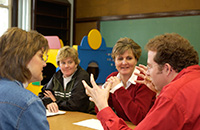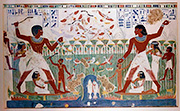To meet the needs of the widest range of students, what should teachers consider when planning their instruction?
Page 4: Goals
 The teachers at Sycamore Middle School are accustomed to identifying learning goals that are clearly stated, observable, measurable, and that align with grade-level standards. As a practice exercise, the team attempts to apply what they have learned about UDL to a social studies goal developed by one sixth-grade teacher: “The students will read the textbook chapter about ancient Egypt and write in cursive a 500-word report about burial customs.” Though the goal is clearly stated, observable, and measurable, the team members agree that it does not adhere to the three UDL principles. They discuss several barriers that may prevent all students in the class from achieving this goal.
The teachers at Sycamore Middle School are accustomed to identifying learning goals that are clearly stated, observable, measurable, and that align with grade-level standards. As a practice exercise, the team attempts to apply what they have learned about UDL to a social studies goal developed by one sixth-grade teacher: “The students will read the textbook chapter about ancient Egypt and write in cursive a 500-word report about burial customs.” Though the goal is clearly stated, observable, and measurable, the team members agree that it does not adhere to the three UDL principles. They discuss several barriers that may prevent all students in the class from achieving this goal.
Traditional Goal: The students will read the textbook chapter about ancient Egypt and write in cursive a 500-word report about burial customs.
Representation barriers:
|
Action and Expression barriers:
|
| Engagement issues are often not addressed in traditional goals such as the one suggested above. | |
In the example, the intent of the learning goal could be for the students to a) learn about ancient Egypt, b) to create and write by hand a 500-word report, or c) both. In this particular instance, the teacher wants the students to learn about ancient Egypt. However, he has inadvertently limited the means by which the students can learn the content (i.e., read a textbook chapter) and demonstrate their knowledge (i.e., write in cursive a 500-word report). This is a common occurrence: Teachers unintentionally create learning goals that limit the means by which their students can achieve the goal.
UDL Goal
 The Sycamore team learns that the principles of UDL can be applied so that all students can meet the learning goal. As was outlined above, a teacher must first know the intent of the learning goal he or she wishes to create. Once this is accomplished, he or she can allow students multiple ways to access and demonstrate their learning.
The Sycamore team learns that the principles of UDL can be applied so that all students can meet the learning goal. As was outlined above, a teacher must first know the intent of the learning goal he or she wishes to create. Once this is accomplished, he or she can allow students multiple ways to access and demonstrate their learning.
The team now realizes that their goal needs to specify that the students will learn about ancient Egypt, and should not involve learning about writing a report. They thus set about applying UDL principles to rewrite the goal in a way that does not confound the means that students use to access information or to demonstrate their knowledge.
UDL Goal: The students will learn about and present information about the burial customs of ancient Egypt.
|
Representation: Students are still required to learn about the burial customs of ancient Egypt, but they are now permitted to use alternate methods for accessing that information (e.g., audio books, digital text, internet, video). |
Action and Expression: The students still need to demonstrate that they learned about the burial customs of ancient Egypt, but they now have options for doing so (e.g., handwriting a report, making a film, recording a presentation, creating a diorama). |
| Issues with engagement are addressed in how students choose to access the content and how they demonstrate their knowledge. Students will complete the assignment in accordance with their learning need or preference (i.e., visual, auditory, tactile, kinesthetic). | |
Additionally, now that the teachers have identified the intent of the learning goal, they can more easily provide scaffolded instruction and support their students. For example, David is overwhelmed by the number of resources he found on ancient Egypt. The teacher helps David to narrow his list of websites or books to a few that he will initially consult.
scaffolded instruction
Instructional technique in which teachers offer support for students learning new skills by systematically building on their experiences and knowledge until they can apply the new skills independently.
Grace Meo further describes how teachers can identify a goal that is not restricted to one particular means of achieving it (time: 1:08).

Grace Meo
Former CAST Director of Professional
Development & Outreach Services
Transcript: Grace Meo
Focus on identifying a goal that does not embed the means, the how to achieve the goal, since once you embed the how into the goal you’re actually restricting the goal to a certain population of students. You want to remove barriers. You want to design the goal so it is encompassing of all students. For example, if one were to set a goal of writing an essay on the causes and effects of the Civil War, what would happen by including the word “write,” you’re going to eliminate those students for whom writing is a difficult task. If in fact, though, the goal is a skill goal in which you really do want the students to write a particular thing, then you have to provide scaffolds for the students that have difficulty in achieving that goal. It might be that the process of writing, using a pencil and paper is the difficulty, so you might provide an alternative such as a computer. Or, if it’s difficult for a student to understand how to get started, you might provide a sentence starter or structure for the student so they can, in fact, achieve the goal that you want to achieve.
Activity
 Given the traditionally stated goal below, help the teachers at Sycamore Middle School to a) identify potential barriers that might make it difficult for some students to achieve the goal and b) rewrite the goal so that it incorporates UDL principles. In this case, the intent of the project is for students to learn about a child’s experience during the Holocaust and to present this information to the class.
Given the traditionally stated goal below, help the teachers at Sycamore Middle School to a) identify potential barriers that might make it difficult for some students to achieve the goal and b) rewrite the goal so that it incorporates UDL principles. In this case, the intent of the project is for students to learn about a child’s experience during the Holocaust and to present this information to the class.
The students will read the book Anne Frank: The Diary of a Young Girl and give a five-minute oral presentation about the author’s experiences.
| Traditional Goal: The students will read the book Anne Frank: The Diary of a Young Girl and give a five-minute oral presentation about the author’s experiences. |
Some of the barriers that might make it difficult for some students to achieve this goal are listed below.
Representation barriers:
|
Action and Expression barriers:
|
Engagement issues:
|
|
| One Possible UDL Goal: The students will access a biography or autobiography of a child’s experiences during the Holocaust through their preferred medium and will complete a project to summarize the child’s experiences. |
| Representation:
This goal allows students to access the content of the book through multiple formats (e.g., printed text, digitized text, audio book). |
Action and Expression:
This goal allows the students to demonstrate their knowledge of the book using alternate methods (e.g., written report, diorama, oral presentation). |
| Engagement:
This goal allows the students to select a book that appeals to them. The teacher may provide a list of biographies and autobiographies from which to choose (e.g., Anne Frank: The Diary of a Young Girl, The Upstairs Room, Upon the Head of the Goat: A Childhood in Hungary 1939-1944). Additionally, the students can choose how to access the content and demonstrate what they have learned using methods that may reflect their preferred learning modalities. |
|